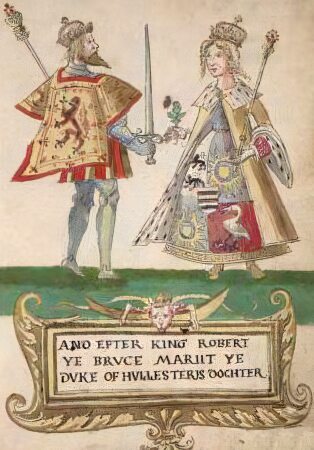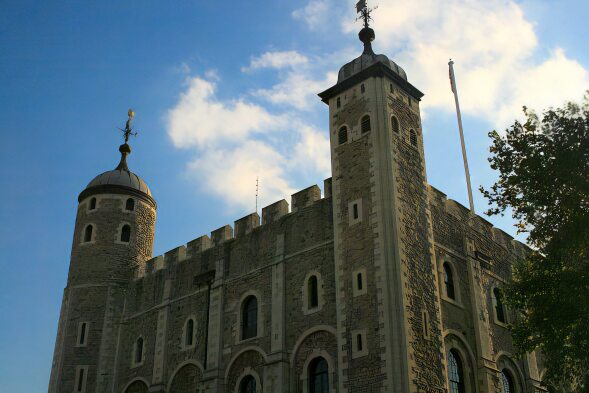Queen of Scots
Elizabeth de Burgh was the daughter of Richard Óg de Burgh, 2nd Earl of Ulster, and Margarite de Burgh, daughter of John de Burgh and Cecily Baillol. She was born circa 1289 at Dunfermline. Fife.
Robert the Bruce, Earl of Carricks's first wife Isabella of Mar had died in childbirth six years previously, leaving him with just a daughter, Marjorie Bruce, the Bruce was at the time supporting King Edward I of England and probably met Elizabeth, his future wife, at the English court. Elizabeth's father the Earl of Ulster was a powerful Anglo-Irish lord and a close ally of King Edward. Elizabeth and Robert were married in 1302 at Writtle in Essex. The bride was then around thirteen years old, while the groom was twenty-eight.
Robrt the Bruce and Elizabeth de Burgh
Robert the Bruce and Elizabeth were later crowned as King and Queen of Scots at Scone Abbey on 27 March 1306. The coronation was carried out in defiance of the Edward I's claim of suzerainty over Scotland.
Three months later, in June 1306, Robert the Bruce was defeated in battle by the forces of King Edward I at Methven. Robert sent his daughter by his first marriage, Marjorie, his wife Elizabeth and his two sisters north to Isabella MacDuff, Countess of Buchan for their safety, they were escorted by King Robert's brother, Niall Bruce and the Earl of Atholl.
It was intended that they would then take refuge in Orkney, but were besieged by the English at Kildrummy Castle, after the castle was taken, the English had Niall Bruce hung, drawn and quartered, along with all the male defenders of the castle, but the royal ladies, escorted by the Earl of Athol, escaped on to Tain, to the north of Inverness, where they were desperately hoping to obtain a boat.
They were captured by the Earl of Ross, a supporter of the Comyns, in the sanctuary of St. Duthac and sent to Edward of England, then at Lanercost Priory in Cumberland. Edward then sent his hostages to different places in England.
Marjorie Bruce went to the Gilbertine convent at Watton, Christina Bruce was sent to another convent, Elizabeth de Burgh, who was treated more leniently since Edward wished to ensure the loyalty of her father, Richard de Burgh, was placed under house arrest at a manor house in Yorkshire and was allowed to have two elderly women in attendance. Mary Bruce and the Countess of Buchan, who had crowned Robert the Bruce, were imprisoned in wood and iron lattice cages, exposed to public view, Mary's cage at Roxburgh Castle and Countess Isabella's at Berwick Castle.
The Tower of London
The Earl of Atholl was hanged and his head displayed on London Bridge. Even Edward's ardent admirer, Sir Maurice Powicke wrote of his 'peculiar ferocity' in the instance of these women prisoners. The Countess of Buchan remained in her cage for nearly four years, a spectacle for the curious, she was treated like an animal in a menagerie, until 1310, when Edward II allowed her to be taken to the House of the Carmelites at Berwick. For the next four years, Marjorie herself endured solitary confinement, a cage was built for her at the Tower of London, but Edward reconsidered and instead sent her to the convent. Christopher Seton, Christina Bruce's husband, was executed.
King Edward I breathed his last at Burgh on Sands on 7 July 1307 and was succeeded on the English throne by his ineffectual son, Edward II, who continued to hold the Scots prisoners for around seven more years.
During her English captivity, Elizabeth was moved about between various residences including the Tower of London. An undated letter written by Elizabeth from Holderness in which she complains she only has three changes of clothing, no headgear and nothing for her bed. When she reached the Tower in 1312, her conditions began to improve. Elizabeth de Burgh and the other ladies were finally released in around 1314, possibly in exchange for English nobles captured after the Scottish victory of the The Battle of Bannockburn.
On her return to Scotland, she and her husband went on to have four children, three of whom survived to adulthood, two daughters, Matilda and Margaret, and David, the future king David II of Scotland, a further son John died young.
Elizabeth died on 27 October 1327 at Cullen Castle in Banffshire and was buried at Dunfermline Abbey. Her husband, died 18 months later
Isabella of Mar PreviousNext David II
